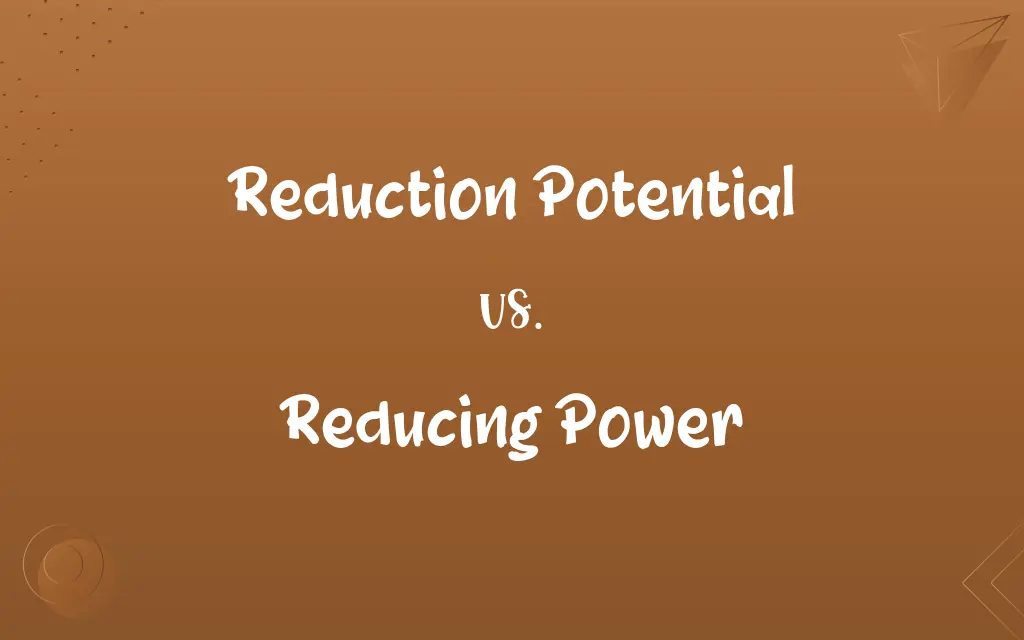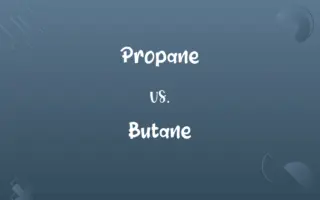Reduction Potential vs. Reducing Power: Know the Difference

By Shumaila Saeed || Updated on December 25, 2023
Reduction potential is a measure of the tendency of a chemical species to acquire electrons, while reducing power refers to the ability of a substance to donate electrons.

Key Differences
Reduction Potential, also known as redox potential, is a quantitative measure of a substance's ability to gain electrons and thereby be reduced. It is expressed in volts and indicates how strongly an oxidizing agent can accept electrons. Reducing Power refers to a substance's ability to donate electrons to another substance, acting as a reducing agent. This is a qualitative concept, indicating how effectively a substance can reduce others.
Shumaila Saeed
Dec 22, 2023
A high reduction potential means a species is a strong oxidizing agent and readily accepts electrons. It is a central concept in electrochemistry and is used in determining the direction of redox reactions. Reducing Power is demonstrated by substances with a low reduction potential, indicating they readily donate electrons to other substances. It is a key factor in many chemical and biological processes, including metabolism and photosynthesis.
Shumaila Saeed
Dec 22, 2023
The reduction potential is determined under standard conditions and is tabulated in the standard electrode potential table, providing a reference for comparing different substances. It can be positive or negative, with a more positive value indicating a greater tendency to gain electrons. Reducing Power is often related to the structure of a molecule, where elements or compounds with excess electrons or certain electron configurations tend to have high reducing power.
Shumaila Saeed
Dec 22, 2023
In practical applications, reduction potential is used in predicting the outcome of electrochemical cells, such as batteries, and in the electroplating process. Substances with high reduction potentials are effective in driving redox reactions as cathodes. Reducing Power is a key characteristic in antioxidants, where substances donate electrons to neutralize free radicals, and in industrial processes where reducing agents are used to facilitate chemical reactions.
Shumaila Saeed
Dec 22, 2023
In summary, reduction potential and reducing power are complementary concepts in redox chemistry. Reduction potential quantifies a substance's tendency to accept electrons, while reducing power describes the tendency to donate electrons. Both are crucial in understanding and predicting the behavior of substances in redox reactions.
Shumaila Saeed
Dec 22, 2023
ADVERTISEMENT
Comparison Chart
Definition
Measure of a species' tendency to gain electrons
Ability of a substance to donate electrons
Shumaila Saeed
Dec 22, 2023
Role in Redox Reaction
Indicates oxidizing ability
Indicates reducing ability
Shumaila Saeed
Dec 22, 2023
Typical Values
High values for strong oxidizers
High in substances that readily donate electrons
Shumaila Saeed
Dec 22, 2023
Application
Predicting outcomes in electrochemistry
Used in identifying antioxidants and reducing agents
Shumaila Saeed
Dec 22, 2023
ADVERTISEMENT
Reduction Potential and Reducing Power Definitions
Reduction Potential
A property used to predict the direction of redox reactions.
By comparing reduction potentials, we can determine which direction a redox reaction will proceed.
Shumaila Saeed
Dec 11, 2023
Reducing Power
The capability of a molecule to reduce another molecule.
Sodium borohydride is used in organic synthesis due to its high reducing power.
Shumaila Saeed
Dec 11, 2023
Reduction Potential
A standard measurement in volts under standard conditions.
Standard reduction potentials are used to calculate the cell potential of electrochemical cells.
Shumaila Saeed
Dec 11, 2023
Reducing Power
A characteristic of substances that act as reducing agents.
The reducing power of antioxidants is crucial in neutralizing free radicals.
Shumaila Saeed
Dec 11, 2023
Reduction Potential
A quantitative value that indicates how strongly a substance can be reduced.
The reduction potential of copper is higher than that of iron, making it a better oxidizer.
Shumaila Saeed
Dec 11, 2023
ADVERTISEMENT
Reducing Power
The ability of a substance to donate electrons in a redox reaction.
Hydrogen has significant reducing power due to its ability to easily donate electrons.
Shumaila Saeed
Dec 11, 2023
Reduction Potential
The potential at which reduction occurs at an electrode.
The electrode with the higher reduction potential will act as the cathode in an electrochemical cell.
Shumaila Saeed
Dec 11, 2023
Reducing Power
A measure of how effectively a substance can donate electrons.
In redox reactions, a substance’s reducing power determines its effectiveness as a reductant.
Shumaila Saeed
Dec 11, 2023
Reduction Potential
The measure of the tendency of a chemical species to acquire electrons.
A high reduction potential indicates a strong ability to act as an oxidizing agent.
Shumaila Saeed
Dec 11, 2023
Reducing Power
The property of a compound to undergo oxidation by losing electrons.
Metals like zinc and iron are often used in reactions for their strong reducing power.
Shumaila Saeed
Dec 11, 2023
Repeatedly Asked Queries
What is reduction potential?
Reduction potential is a measure of the tendency of a chemical species to gain electrons.
Shumaila Saeed
Dec 22, 2023
How is reduction potential measured?
Reduction potential is measured in volts under standard conditions.
Shumaila Saeed
Dec 22, 2023
What does a high reduction potential indicate?
A high reduction potential indicates a strong tendency to act as an oxidizing agent.
Shumaila Saeed
Dec 22, 2023
Can reducing power be quantified?
Reducing power is typically a qualitative measure, not usually quantified like reduction potential.
Shumaila Saeed
Dec 22, 2023
How is reducing power defined?
Reducing power refers to the ability of a substance to donate electrons.
Shumaila Saeed
Dec 22, 2023
How do reduction potential and reducing power relate to redox reactions?
Reduction potential predicts the direction of redox reactions, while reducing power indicates a substance's ability to act as a reductant.
Shumaila Saeed
Dec 22, 2023
What factors affect reducing power?
Reducing power is influenced by molecular structure, electron configuration, and the presence of excess electrons.
Shumaila Saeed
Dec 22, 2023
Is reduction potential constant for a given substance?
Reduction potential can vary with different conditions, but standard reduction potentials are constant values.
Shumaila Saeed
Dec 22, 2023
What is an example of a substance with high reducing power?
Sodium borohydride is an example of a substance with high reducing power.
Shumaila Saeed
Dec 22, 2023
What role does reduction potential play in electrochemistry?
Reduction potential is key in predicting the behavior of substances in electrochemical cells.
Shumaila Saeed
Dec 22, 2023
How do electrochemical cells utilize reduction potential?
Electrochemical cells utilize reduction potential to drive the flow of electrons from the anode to the cathode.
Shumaila Saeed
Dec 22, 2023
Are reduction potential and reducing power inversely related?
Generally, a substance with a high reduction potential has low reducing power, and vice versa.
Shumaila Saeed
Dec 22, 2023
Can reducing power affect environmental processes?
Yes, the reducing power of various substances can impact environmental processes like the degradation of pollutants.
Shumaila Saeed
Dec 22, 2023
What is the standard reduction potential?
Standard reduction potential is the reduction potential of a substance measured under standard conditions (1 M concentration, 1 atm pressure, 25°C).
Shumaila Saeed
Dec 22, 2023
Why is reducing power important in industrial processes?
Reducing power is important in industrial processes for reducing metals from their ores and in chemical synthesis.
Shumaila Saeed
Dec 22, 2023
Can reducing power be increased?
Reducing power can be increased by altering the molecular structure to favor electron donation.
Shumaila Saeed
Dec 22, 2023
How is reduction potential used in batteries?
In batteries, reduction potential determines which materials are suitable for use as cathodes and anodes.
Shumaila Saeed
Dec 22, 2023
Can reduction potential predict reaction spontaneity?
Yes, comparing reduction potentials can predict the spontaneity of a redox reaction.
Shumaila Saeed
Dec 22, 2023
How does temperature affect reducing power?
Temperature can affect reducing power, often increasing it with higher temperatures.
Shumaila Saeed
Dec 22, 2023
What is the significance of reducing power in antioxidants?
The reducing power of antioxidants is crucial for their ability to neutralize harmful free radicals.
Shumaila Saeed
Dec 22, 2023
Share this page
Link for your blog / website
HTML
Link to share via messenger
About Author
Written by
Shumaila SaeedShumaila Saeed, an expert content creator with 6 years of experience, specializes in distilling complex topics into easily digestible comparisons, shining a light on the nuances that both inform and educate readers with clarity and accuracy.









































































